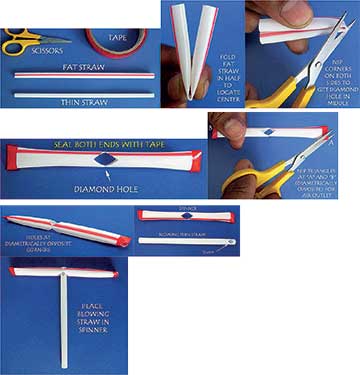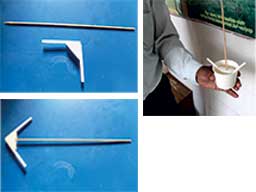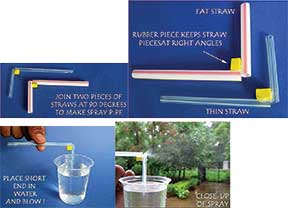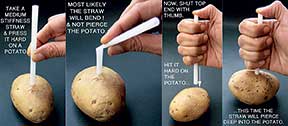Manish Jain
Straw spinner

Materials required: A thick straw, a thin straw, a scissor, and a tape.
Experiment: Fold the thick straw in half so that you can get the centre of the straw and now cut the ends. You will now have two diamond shaped holes in the straw. The thinner straw should fit easily (loosely) inside this hole. Place the straw so that holes are facing up and cut two corners of the straw. Seal both these ends with a tape. On each of these ends make triangular cuts on the diametrically opposite corners. This is the straw that spins and we will call it the spinner.
Now, take the thin straw. Cut out a diamond shape at one end of this straw. Note this will not be a hole as in the thick straw on both sides. This is a hole only on one side of the straw. We shall call this our blowing straw.
The straw spinner is ready.
Place the blowing straw in the spinner by pushing the diamond cut end through the diamond opening at the centre of the spinner. The spinner and the blower now form a T shape. Shut one end of the blowing straw with your finger and blow to see the spinner spin.
Things to take care: The thin straw should fit loosely. Try keeping the blowing straw facing down vertically with your mouth on top and spinner down when you blow. This will make the spinner stay down on the hole of the blowing straw.
Explanation: This is a classical Newton’s third law in action (Every action has an equal and opposite reaction). Air coming out of the straw (action) and force on the straw spinner in opposite direction (reaction). As you blow air through the thin straw, the air finds an outlet through the two triangular openings at the diametrically opposite ends of the spinner straw. As the air rushes out, it pushes the straw in the opposite direction. Force on both the ends are in opposite direction, but the torque is in same direction. So the spinner spins. As long as you blow, the straw gets a steady torque from the two streams of rushing out air and it spins.
Further explorations: This is a great experiment to explore further.
- Make a single cut on the spinner for the air to come out. See if the straw spins. (It should).
- Make cuts on same side of the spinner straw. Now try (It shouldn’t).
- Make the cuts in the middle of the end of the spinner straw (instead of corners). (It shouldn’t spin).
- Cut the holes on the spinner straw anywhere else along the length instead of the ends and observe.
- As a first step we made the hole in the centre of the thick straw for it to spin. Try doing the same experiment with the hole off the centre. See what happens.
Video link: Video link: https://www.youtube.com/watch?v=gyuL4Q1hW9k
Two-in-one toy
Straw mist and straw sprinkler

Materials required: A straw, a wooden stick, scissors, tape, a glass of water.
Experiment: This is a great and yet extremely simple toy that children can play with. It illustrates some basic concepts and is great toy to have fun in the class. This is a 2-in-1 toy.
Take a straw that is of medium stiffness and cut it two equal parts. Join the two pieces of the straw at right angles using a rubber piece. Make sure that one straw covers the opening of the other straw. In other words, at the joints, place the two straws so that one of the straws come over the other straw. The straw that comes over goes in the water and the straw that is blocked becomes the blower.
Put the blower in the mouth, dip the other straw in the glass of water and blow hard. A wonderful mist or spray will come out. It is great toy to play with in summer.
Now insert or attach a stick on the rubber piece so that this stick divides the 90 degree angle of the straws in two equal parts. Hold the stick, dip the joint of the straws in water and spin the stick. This becomes a sprinkler as the water will come out of the other end of straw like a sprinkler.
Explanation of mist/Spray: As you blow through the straw, the air rushes out with great speed. Some path of the air is blocked by the other straw so the air goes over this other straw with even greater speed. This leads to a low pressure over the other straw and water rises in this straw. Rising water hits the air and becomes a mist/spray. The creation of low pressure due to high speed air is according to Bernoulli’s principle. This is the same principle which says that we should not stand near a fast moving train as low pressure created there can suck us towards the train and consequences can be extremely dangerous.

Explanation of sprinkler: Spinning things tend to fly out. So when we spin the stick, the two cut straws spin with it. They have some water inside since they are dipped in water. This water experiences centrifugal force and this force makes it try to go outside. Hence it rises up the straw. The more it rises, the higher the force that it feels since it is farther away from the centre and so it goes all the way to the top and flies out of the straw like a sprinkler.
Further explorations:
- Put a stiff straw instead of the stick in the middle. Does the water come out of this straw also when you spin this vertical straw. Why ? The answer lies in the distance this straw is away from the spinning axis.
- Try keeping the straws at different angles to the spinning axis. In this experiment it is at 45 degrees. At which angle does the water go the farthest?
- One of the most interesting observations is to figure out the path of each droplet coming out of the straw goes slightly up and then falls down. What is the exact path of this droplet? Is it in one plane or curvy? If you have a phone which can take slow motion video you can see the path of the droplet.
- It will be fun to prove that the path of the droplet will be in a vertical plane which does not pass through the plane of the straw it is coming out of also but away from the plane of the straw towards the direction of spin.
Video links: https://www.youtube.com/watch?v=YCIyvX0NsuU
https://www.youtube.com/watch?v=jS-JrWfhEJI
Piercing a potato

Materials required: A piece of straw, a potato.
Experiment: This is an interesting game/challenge to pierce a potato with a straw.
Cut a straw of medium stiffness at an angle and try to pierce this inside a potato. The straw will bend and will not go inside the potato.
Now close the top end of the straw with your thumb and hit it hard on the potato. Now the straw will pierce deep into the potato.
Explanation: The extremely quick and sharp movement of the straw gives a very large force. If we were to twist and push gradually the force delivered will be much lesser. So you will not be able to do it.
Also, the straw has a very little surface area which contacts the potato. Hence the impact is large. The area of contact of the straw with the potato is the circumference of the straw times the thickness of straw, which is very less. Hence the amount of potato that the straw has to pierce or push is much lesser. If we try the same thing with a pencil, the amount of potato to be moved is much more, so we won’t be able to do it.
Misconception: There is a misconception that it has to do with the air trapped in the straw. You can actually do this experiment without closing the straw. You just have to do this extremely fast. So the trick is the impulse and not the trapped air. Now it might help, but on impact the air will get compressed so the part of the straw which is piercing is without any air. The part of the straw that is remaining outside will have air (compressed) and will make the straw much stiffer. But this does not lead to piercing of the potato.
Video link: https://www.youtube.com/watch?v=_D6-Q3Tep_E
The author is an active and peripatetic member of Arvind Gupta Toys. He travels all over the country giving demonstrations of the toys. He can be reached at manishjain@gmail.com.
